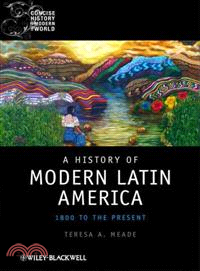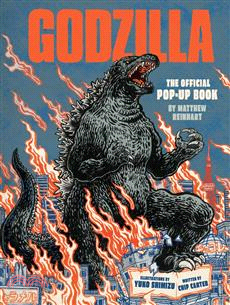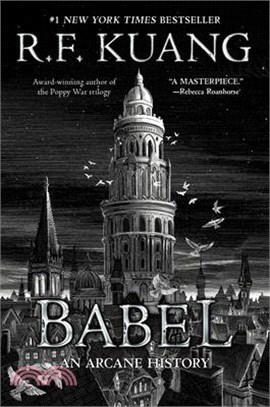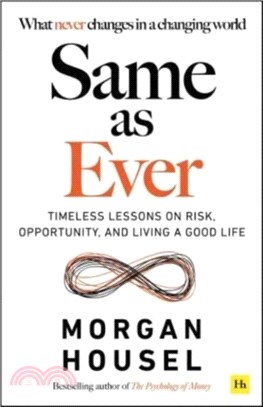HISTORY OF MODERN LATIN AMERICA - 1800 TO THE PRESENT
商品資訊
系列名:Blackwell Concise History of the Modern World
ISBN13:9781405120517
出版社:JOHN WILEY & SONS;LTD
作者:MEADE
出版日:2009/11/27
裝訂/頁數:平裝/416頁
規格:24.8cm*17.1cm*2.5cm (高/寬/厚)
商品簡介
作者簡介
目次
相關商品
商品簡介
A History of Modern Latin America: 1800 to the Present examines the diverse and interlocking experiences of people of indigenous, African, and European backgrounds from the onset of independence until today.
Illustrates and analyzes the major and minor events that shape history, the triumphs and defeats, and the everyday lives of people of varied classes and racial and ethnic backgrounds
Intersperses accounts of the lives of prominent figures with those of ordinary people
Emphasizes gender's role in influencing political and economic change and shaping cultural identity
Student and instructor resources available at http://minerva.union.edu/meadet/modernlatinamerica/index.html
[Wiley disclaims all responsibility and liability for the content of any third-party websites that can be linked to from this website. Users assume sole responsibility for accessing third-party websites and the use of any content appearing on such websites. Any views expressed in such websites are the views of the authors of the content appearing on those websites and not the views of Wiley or its affiliates, nor do they in any way represent an endorsement by Wiley or its affiliates.]
Custom Select
Create a customized edition with Wiley Custom Select
CourseSmart
Instant access to textbooks as eTextbooks. Learn more at coursesmart.com
Illustrates and analyzes the major and minor events that shape history, the triumphs and defeats, and the everyday lives of people of varied classes and racial and ethnic backgrounds
Intersperses accounts of the lives of prominent figures with those of ordinary people
Emphasizes gender's role in influencing political and economic change and shaping cultural identity
Student and instructor resources available at http://minerva.union.edu/meadet/modernlatinamerica/index.html
[Wiley disclaims all responsibility and liability for the content of any third-party websites that can be linked to from this website. Users assume sole responsibility for accessing third-party websites and the use of any content appearing on such websites. Any views expressed in such websites are the views of the authors of the content appearing on those websites and not the views of Wiley or its affiliates, nor do they in any way represent an endorsement by Wiley or its affiliates.]
Custom Select
Create a customized edition with Wiley Custom Select
CourseSmart
Instant access to textbooks as eTextbooks. Learn more at coursesmart.com
作者簡介
Teresa A. Meade is Florence B. Sherwood Professor of History and Culture at Union College, New York. She is the author of “Civilizing” Rio: Reform and Resistance in a Brazilian City (1997), A Brief History of Brazil, 2nd edition (2009), and co-editor of the Blackwell Companion to Gender History (2004) and Science, Medicine and Cultural Imperialism (1991). She has written widely on Latin America, and on women and gender history.
目次
List of Figures
List of Maps
Preface
Acknowledgments
1 Introduction to the Land and Its People
Geography
People
Economies
Politics
Culture and Entertainment
Latin America: Past and Present
2 Latin America in 1790
Colonial Background
Power and Privilege
Land
Colonial Administration
Enlightened Monarchy
The Agents of the Reform
Disorder and Rebellion
Discontent and Disorder in Brazil
Changing Gender Roles
On the Road to Independence
Nationalism and American Culture
Conclusion
3 Competing Notions of Freedom
Five Roads to Independence
African Slavery in the Americas
Slavery and the Countryside
Slavery in the Cities
Treatment and Punishment
Slavery and the Church
African Medicine and Religious Practices
Resistance and Rebellion
The Sugar Colony of Saint-Domingue
The Slave Revolt
The Revolution Betrayed
Brazil’s Independent Empire
Independence in Mexico
South American Independence
Post-independence Changes in Racial and Gender Status
The Last Holdout of Slavery in Spanish America
Latin America in a Changing World Order
Conclusion
4 Fragmented Nationalisms
Searching for Political and Economic Unity
New World "Feudalism"
Post-independence Politics
Argentina and the Tyrants
Populist Caudillismo: Paraguay and Bolivia
After Caudillismo
Race, Race Mixture, and Liberalism
Gender and Liberalism
Intersections of Gender, Race, and Class
Nationalism
Conclusion
5 Latin America’s Place in the Commodity Chain
The Guano Boom
Nitrates in Chile
Sugar and Coffee
The Growth of São Paulo
Colombian Coffee
The Rubber Boom
Expanding Exports
Mexico and US Expansion
The North American Invasion
General López de Santa Anna
The New Age of Imperialism
Central America and the Panama Canal
Ecuador and the "Panama" Hat
Independence at Last? Cuba and Puerto Rico
Conclusion
6 Immigration, and Urban and Rural Life
Asian Immigration
European Immigration
The Southern Cone
Life on the Pampas
British Investment
The Changing Cultural Landscape
Urban Renewal
Mexico and Benito Juárez
French Invasions
The Rise of Porfirio Díaz
Intellectual Theories: Positivism and Eugenics
Conclusion
7 Revolution from Countryside to City: Mexico
The Porfiriato
Opposition to the Porfiriato
Constitutional Opposition
Madero Assassinated
US Intervention
Women in Combat
Carranza as President
The Constitution of 1917
Aftermath of Struggle
Agrarian Revolts in Latin America
Conclusion
8 The Left and the Socialist Alternative
Socialism on the World Stage
Social Reform and the Middle Class
Anarchism, Socialism, and Anarcho-syndicalism
Women in the Workforce
Colombia: Resistance to the United Fruit Company
The Labor Movement
Socialism and the Arts
Tenentes Revolt and Brazilian Communism
Modern Art Week in Brazil
Women in the Arts
Socialism vs. Capitalism
José Carlos Mariátegui
Conclusion
9 Populism and the Struggle for Change
Getúlio Vargas and "New State" Politics
Juan Perón and Peronism
Perón’s Fall from Grace
Politics Engendered
Revolutionizing Mexico: Lázaro Cárdenas
Populism in Colombia and Peru
Central America
The Long Twentieth Century
Conclusion
10 Post-World War II Struggles for Sovereignty
World War II
Temporary Worker Program
Post-war Latin America
Military vs. Civilian Rule
The Absolute Dictator: Rafael Trujillo
Americas in Transition: Guatemala and Bolivia
Guatemala
Revolution in Bolivia
Mining and the Voice of Bolivian Activism
The Revolution in Decline
Conclusion
11 Cuba: Guerrillas Take Power
"History Will Absolve Me"
Causes for Discontent
The Revolutionary War
The Special Period in Peacetime
Cuba and the World
Ernesto "Che" Guevara
What Difference Did the Revolution Make?
Democratic Shortcomings
Conclusion
12 Progress and Reaction
Modernization and Progress
Brazil’s Military Coup
The National Security State
Latin America’s Youth Movement
Mexico
The Massacre at Tlateloco
The Chilean Road to Socialism
The Chilean Road to Socialism Dead Ends
Urban Guerrilla Warfare: Uruguay
Urban Guerrilla Warfare: Argentina
Dictatorship and State Terror
Mothers of the Plaza de Mayo
The War of the Malvinas/Falkland Islands
Movements for Revolutionary Change: Peru
Sendero Luminoso, the Shining Path
Women and Shining Path
Repression and Fujimori
Conclusion
13 Revolution and Its Alternatives
A Changing Catholic Church
Marxism and Catholic Humanism
The Opposition
The Somozas versus Sandino: the Next Generation
The Sandinista Opposition
Sandinistas in Power
United States and the Sandinistas
Effects of the Contra War
Central America in Turmoil: El Salvador and Guatemala
Politics of Repression in El Salvador
The Opposition
The Fighting Ends
Guatemala: The Bloodiest War
The Evangelical Alternative
Colombia: The Longest War
The War on Drugs in Latin America
Conclusion
14 The Americas in the Twenty-first Century
The Washington Consensus
Brazil and the Workers’ Alternative
The Workers’ Party in Power
Bolivia: Twenty-first-century Indigenismo
Venezuela and Hugo Chávez
The Bolivarian Mission
Chávez and "the Pink Tide"
Complicating Social Ties
Chile’s Transition to Democracy
New Social Movements
Movements for Racial and Gender Equality
Women and Politics
The Latin Americanization of the United States
Immigration and Free Trade
Opponents Confront Free Trade
Immigration and Neoliberalism
Sharing the Environment and the Cost of Stewardship
Notes
Glossary
Further Reading
Index
List of Maps
Preface
Acknowledgments
1 Introduction to the Land and Its People
Geography
People
Economies
Politics
Culture and Entertainment
Latin America: Past and Present
2 Latin America in 1790
Colonial Background
Power and Privilege
Land
Colonial Administration
Enlightened Monarchy
The Agents of the Reform
Disorder and Rebellion
Discontent and Disorder in Brazil
Changing Gender Roles
On the Road to Independence
Nationalism and American Culture
Conclusion
3 Competing Notions of Freedom
Five Roads to Independence
African Slavery in the Americas
Slavery and the Countryside
Slavery in the Cities
Treatment and Punishment
Slavery and the Church
African Medicine and Religious Practices
Resistance and Rebellion
The Sugar Colony of Saint-Domingue
The Slave Revolt
The Revolution Betrayed
Brazil’s Independent Empire
Independence in Mexico
South American Independence
Post-independence Changes in Racial and Gender Status
The Last Holdout of Slavery in Spanish America
Latin America in a Changing World Order
Conclusion
4 Fragmented Nationalisms
Searching for Political and Economic Unity
New World "Feudalism"
Post-independence Politics
Argentina and the Tyrants
Populist Caudillismo: Paraguay and Bolivia
After Caudillismo
Race, Race Mixture, and Liberalism
Gender and Liberalism
Intersections of Gender, Race, and Class
Nationalism
Conclusion
5 Latin America’s Place in the Commodity Chain
The Guano Boom
Nitrates in Chile
Sugar and Coffee
The Growth of São Paulo
Colombian Coffee
The Rubber Boom
Expanding Exports
Mexico and US Expansion
The North American Invasion
General López de Santa Anna
The New Age of Imperialism
Central America and the Panama Canal
Ecuador and the "Panama" Hat
Independence at Last? Cuba and Puerto Rico
Conclusion
6 Immigration, and Urban and Rural Life
Asian Immigration
European Immigration
The Southern Cone
Life on the Pampas
British Investment
The Changing Cultural Landscape
Urban Renewal
Mexico and Benito Juárez
French Invasions
The Rise of Porfirio Díaz
Intellectual Theories: Positivism and Eugenics
Conclusion
7 Revolution from Countryside to City: Mexico
The Porfiriato
Opposition to the Porfiriato
Constitutional Opposition
Madero Assassinated
US Intervention
Women in Combat
Carranza as President
The Constitution of 1917
Aftermath of Struggle
Agrarian Revolts in Latin America
Conclusion
8 The Left and the Socialist Alternative
Socialism on the World Stage
Social Reform and the Middle Class
Anarchism, Socialism, and Anarcho-syndicalism
Women in the Workforce
Colombia: Resistance to the United Fruit Company
The Labor Movement
Socialism and the Arts
Tenentes Revolt and Brazilian Communism
Modern Art Week in Brazil
Women in the Arts
Socialism vs. Capitalism
José Carlos Mariátegui
Conclusion
9 Populism and the Struggle for Change
Getúlio Vargas and "New State" Politics
Juan Perón and Peronism
Perón’s Fall from Grace
Politics Engendered
Revolutionizing Mexico: Lázaro Cárdenas
Populism in Colombia and Peru
Central America
The Long Twentieth Century
Conclusion
10 Post-World War II Struggles for Sovereignty
World War II
Temporary Worker Program
Post-war Latin America
Military vs. Civilian Rule
The Absolute Dictator: Rafael Trujillo
Americas in Transition: Guatemala and Bolivia
Guatemala
Revolution in Bolivia
Mining and the Voice of Bolivian Activism
The Revolution in Decline
Conclusion
11 Cuba: Guerrillas Take Power
"History Will Absolve Me"
Causes for Discontent
The Revolutionary War
The Special Period in Peacetime
Cuba and the World
Ernesto "Che" Guevara
What Difference Did the Revolution Make?
Democratic Shortcomings
Conclusion
12 Progress and Reaction
Modernization and Progress
Brazil’s Military Coup
The National Security State
Latin America’s Youth Movement
Mexico
The Massacre at Tlateloco
The Chilean Road to Socialism
The Chilean Road to Socialism Dead Ends
Urban Guerrilla Warfare: Uruguay
Urban Guerrilla Warfare: Argentina
Dictatorship and State Terror
Mothers of the Plaza de Mayo
The War of the Malvinas/Falkland Islands
Movements for Revolutionary Change: Peru
Sendero Luminoso, the Shining Path
Women and Shining Path
Repression and Fujimori
Conclusion
13 Revolution and Its Alternatives
A Changing Catholic Church
Marxism and Catholic Humanism
The Opposition
The Somozas versus Sandino: the Next Generation
The Sandinista Opposition
Sandinistas in Power
United States and the Sandinistas
Effects of the Contra War
Central America in Turmoil: El Salvador and Guatemala
Politics of Repression in El Salvador
The Opposition
The Fighting Ends
Guatemala: The Bloodiest War
The Evangelical Alternative
Colombia: The Longest War
The War on Drugs in Latin America
Conclusion
14 The Americas in the Twenty-first Century
The Washington Consensus
Brazil and the Workers’ Alternative
The Workers’ Party in Power
Bolivia: Twenty-first-century Indigenismo
Venezuela and Hugo Chávez
The Bolivarian Mission
Chávez and "the Pink Tide"
Complicating Social Ties
Chile’s Transition to Democracy
New Social Movements
Movements for Racial and Gender Equality
Women and Politics
The Latin Americanization of the United States
Immigration and Free Trade
Opponents Confront Free Trade
Immigration and Neoliberalism
Sharing the Environment and the Cost of Stewardship
Notes
Glossary
Further Reading
Index
主題書展
更多
主題書展
更多書展今日66折
您曾經瀏覽過的商品
購物須知
外文書商品之書封,為出版社提供之樣本。實際出貨商品,以出版社所提供之現有版本為主。部份書籍,因出版社供應狀況特殊,匯率將依實際狀況做調整。
無庫存之商品,在您完成訂單程序之後,將以空運的方式為你下單調貨。為了縮短等待的時間,建議您將外文書與其他商品分開下單,以獲得最快的取貨速度,平均調貨時間為1~2個月。
為了保護您的權益,「三民網路書店」提供會員七日商品鑑賞期(收到商品為起始日)。
若要辦理退貨,請在商品鑑賞期內寄回,且商品必須是全新狀態與完整包裝(商品、附件、發票、隨貨贈品等)否則恕不接受退貨。
























